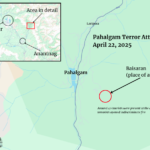When the ground shakes, our lives can change in an instant. On March 28, 2025, a massive 7.7-magnitude earthquake struck central Myanmar, sending tremors that reached as far as Bangkok, Thailand. The quake’s epicenter was near Mandalay, Myanmar, and was followed by a significant 6.4-magnitude aftershock.
1. Bangkok’s High-Rise Horror
In Bangkok, a high-rise building under construction collapsed, resulting in at least two fatalities and trapping numerous individuals under the debris. The city’s governor declared a disaster area, emphasizing the severity of the situation.
2. Myanmar’s State of Emergency
Myanmar’s military government declared a state of emergency in six regions, including the capital Naypyidaw and Mandalay. The quake caused significant damage, such as the collapse of the historic Ava Bridge and destruction to the former royal palace in Mandalay.
3. Casualties and Rescue Efforts
The earthquake resulted in multiple fatalities and injuries across both countries. In Myanmar, several buildings collapsed, including a mosque in Taungoo and a hotel in Aung Ban, leading to deaths and injuries. Rescue operations are ongoing, with emergency responders working tirelessly to locate and assist survivors.
4. Widespread Panic and Evacuations
The tremors caused widespread panic, with residents evacuating buildings and seeking safety in open areas. In Bangkok, people fled into the streets as buildings swayed, and water from rooftop pools spilled over. The city’s BTS skytrain services were suspended, and trading on the stock and futures exchanges was halted.
5. Infrastructure Damage
Beyond building collapses, the earthquake damaged roads and other infrastructure. In Myanmar, roads in the capital buckled, and a major hospital was turned into a “mass casualty area.” In Bangkok, authorities are inspecting buildings for structural integrity and have urged caution due to potential aftershocks.
6. Regional Impact
The earthquake’s effects were felt beyond Myanmar and Thailand. In China, the quake affected Yunnan and Sichuan provinces, causing injuries and structural damage in Ruili.
7. Government Response
Thai Prime Minister Paetongtarn Shinawatra assured the public of safety measures and responses to ongoing aftershocks. Authorities in both countries are coordinating relief efforts, providing aid to those affected, and assessing the full extent of the damage.
In times like these, it’s essential to stay informed and prepared. Earthquakes remind us of the unpredictable nature of our world, but through resilience and community support, we can rebuild and recover. Stay safe!
Next Read -> The Truth About BYD Cars: 5 Shocking Facts You Must Know Before Buying!













